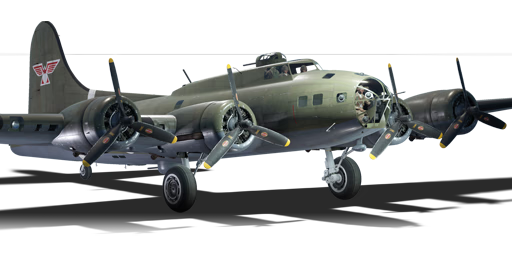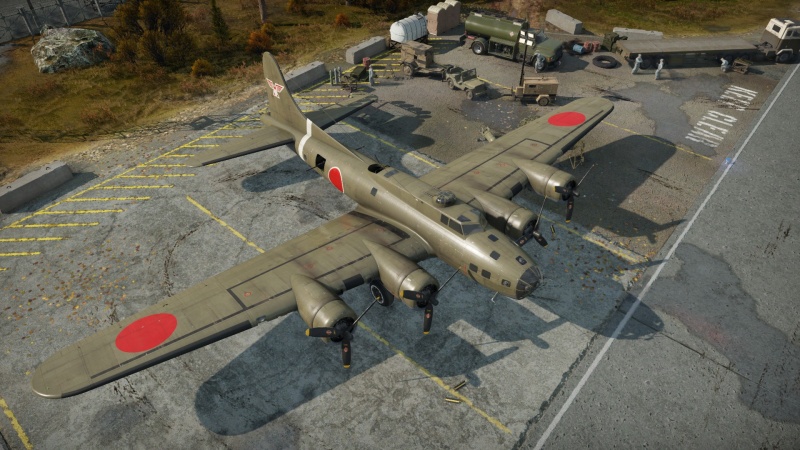Difference between revisions of "B-17E (Japan)"
(Updated format) |
m (→Details) |
||
| Line 60: | Line 60: | ||
! Combat !! Take-off !! Landing !! + !! - | ! Combat !! Take-off !! Landing !! + !! - | ||
|- | |- | ||
| − | | {{Specs|destruction|body}} || {{Specs|destruction|gear}} || | + | | {{Specs|destruction|body}} || {{Specs|destruction|gear}} || 383 || 361 || 249 || ~3 || ~2 |
|- | |- | ||
|} | |} | ||
Revision as of 10:36, 17 February 2021
| This page is about the premium Japanese bomber B-17E (Japan). For other versions, see B-17 (Family). |
Contents
Description
The ▅B-17E Flying Fortress is a premium rank Japanese bomber with a battle rating of (AB), (RB), and (SB). It was introduced in Update 1.43.
The B-17E Flying Fortress, as the name suggests, is intended to be used as a high-altitude level bomber, designed to target enemy airfields, military bases, factories, and other infrastructure crucial to winning the war. Despite its large bomb-load, it is not recommended to target moving ground targets, such as tank formations, unless they are the only targets. This is because of the inaccuracy of the bombs at such high altitude, and since columns will simply disperse when they sight bombs falling. When using the B-17E, it is always best to group up with others in a wedge-like formation for optimal defense against air targets and climb to an altitude of, at least, 4,000 m. A few fighter escorts, would ensure the survival of friendly bombers, only if they adopt fighter-sweep tactics to hunt down enemy fighters converging on the formation.
General info
Flight performance
| Characteristics | Max Speed (km/h at 7,680 m) |
Max altitude (metres) |
Turn time (seconds) |
Rate of climb (metres/second) |
Take-off run (metres) | |||
|---|---|---|---|---|---|---|---|---|
| AB | RB | AB | RB | AB | RB | |||
| Stock | 497 | 483 | 36.9 | 37.9 | 5.8 | 5.6 | 600 | |
| Upgraded | 523 | 510 | 35.1 | 36.0 | 8.7 | 7.2 | ||
Details
| Features | ||||
|---|---|---|---|---|
| Combat flaps | Take-off flaps | Landing flaps | Air brakes | Arrestor gear |
| ✓ | ✓ | ✓ | X | X |
| Limits | ||||||
|---|---|---|---|---|---|---|
| Wings (km/h) | Gear (km/h) | Flaps (km/h) | Max Static G | |||
| Combat | Take-off | Landing | + | - | ||
| 383 | 361 | 249 | ~3 | ~2 | ||
| Optimal velocities (km/h) | |||
|---|---|---|---|
| Ailerons | Rudder | Elevators | Radiator |
| < 330 | < 310 | < 270 | > 300 |
| Compressor (RB/SB) | ||
|---|---|---|
| Setting 1 | ||
| Optimal altitude | 100% Engine power | WEP Engine power |
| 6,180 | 4,000 hp | 4,708 hp |
Survivability and armour
- 6.35 mm Steel plate behind nose gunner
- 6.35 mm Steel plates behind pilots
- 6.35 mm Steel plates behind dorsal gunners
- 6.35 mm Steel plates in front of beam gunners
- 6.35 mm Steel plates in front of tail gunner
- 38 mm Bulletproof glass in front of tail gunner
Modifications and economy
Armaments
Suspended armament
The B-17E (Japan) can be outfitted with the following ordnance:
- 8 x 500 lb AN-M64A1 bombs (4,000 lb total)
- 12 x 500 lb AN-M64A1 bombs (6,000 lb total)
- 6 x 1,000 lb AN-M65A1 bombs (6,000 lb total)
Defensive armament
The B-17E (Japan) is defended by:
- 2 x 12.7 mm M2 Browning machine guns, front dorsal turret (500 rpg = 1,000 total)
- 2 x 12.7 mm M2 Browning machine guns, ventral turret (500 rpg = 1,000 total)
- 2 x 12.7 mm M2 Browning machine guns, tail turret (500 rpg = 1,000 total)
- 1 x 12.7 mm M2 Browning machine gun, rear dorsal turret (500 rpg)
- 1 x 12.7 mm M2 Browning machine gun, 2 x beam turrets (400 rpg)
- 1 x 7.62 mm Browning machine gun, nose turret (500 rpg)
Usage in battles
Generally, the plane's role should not diverge from this norm, as it is ineffective and costly as a low altitude bomber. Survival is an utmost importance to be remembered when using this plane. While one target may be missed, there will always be another opportunity to make another pass once reloaded and repaired. The few M2 machine guns in the nose cannot protect the most vulnerable part of any B-17 - the nose. Protected only by a layer of Plexiglas and almost no armour (excluding the frontal bulkhead, which only covers the pilot/co-pilot's torso), most of the crew critical in the success of the mission, including the pilot, co-pilot, bombardier and navigator would be knocked-out instantly. If targeted by German cannons, most notably, the Mk 108. Just a burst of 30 mm MK 108 placed anywhere on the aircraft , would compromise the crew's survival and even the aircraft's structural integrity.
When facing German fighters and interceptors in realistic battles', it is best to use Omni-purpose or Armour-piercing/Ground Targets ammunition belts for the Browning M2 .50 cal turret machine guns, which is likely to punch through their noses when tailing the B-17E. These ammunition belts are effective at tearing through the engine block of a Focke-Wulf Fw 190D or Messerschmitt Bf 109G, hopefully resulting in an internal engine fire, a pilot snipe, or an inoperable engine for the opponent.
Manual Engine Control
| MEC elements | ||||||
|---|---|---|---|---|---|---|
| Mixer | Pitch | Radiator | Supercharger | Turbocharger | ||
| Oil | Water | Type | ||||
| Controllable | Controllable Auto control available |
Not controllable Not auto controlled |
Controllable Auto control available |
Combined | Controllable 1 gear |
Auto controlled |
Pros and cons
Pros:
- Large payload
- Powerful air defense capabilities
- Multiple engines, can fly on one if necessary (But with a great loss in altitude and speed)
- Rugged design allows for soaking up damage
- Mostly unaffected by light machine gun fire, and to an extent, heavy machine guns
- Good speed for a bomber of its peers
- Multiple turrets covering almost all angles
- Can quite often return to base with extensive damage
- Pilot and co-pilot, if one of them is knocked out, the B-17E can keep flying
Cons:
- Big target
- Fairly Slow
- Nose is extremely vulnerable, the only armour on the front is the front bulkhead, covering only the pilot and copilot's torso
- Vulnerable to German "Minengeschoß" and > 20 mm gunfire
- Engine fires are common
- Wings are big and thus commonly torn off by gunfire
- Nose protection is extremely limited, try to avoid frontal attacks as much as possible
History
In WW2 the Japanese army captured crashed B-17s in the Philippines and Netherlands East Indies. They were tested by the IJAAF Koku Gijutsu Kenkyujo (Air Technical Research Laboratory) at Tachikawa. Little is known about these B-17s, but their historical photographs are valuable to telling the story of the bombers.
Media
Excellent additions to the article would be video guides, screenshots from the game, and photos.
See also
Links to the articles on the War Thunder Wiki that you think will be useful for the reader, for example:
- reference to the series of the aircraft;
- links to approximate analogues of other nations and research trees.
External links
Paste links to sources and external resources, such as:
- topic on the official game forum;
- encyclopedia page on the aircraft;
- other literature.
| Boeing Aircraft | |
|---|---|
| Aircraft | |
| Fighters | P-26A-33 · P-26A-34 M2 · P-26B-35 |
| Bombers | B-17E · B-17E/L · B-17G-60-VE |
| B-29A-BN | |
| Export | P-26A-34 · B-17G |
| Captured | ▅B-17E |
| Helicopters | |
| Attack | AH-64A · AH-64D |
| Export / Licensed | AH-64A (GR) · ▃AH-64A Peten · AH-64A Peten · ▅AH-64DJP · ▄AH Mk.1 · AHS |
| See Also | Tupolev Design Bureau · Westland Helicopters · Fuji Heavy Industries |
| For Boeing-built ships, see Boeing Marine Branch | |
| Japan bombers | |
|---|---|
| Navy | |
| Carrier-based attack bomber | |
| B5N | B5N2 |
| B6N | B6N1 · B6N2 · B6N2a |
| B7A | B7A2 · B7A2 (Homare 23) |
| Carrier-based dive bomber | |
| D3A | D3A1 |
| D4Y | D4Y1 · D4Y2 · D4Y3 Ko |
| Shipboard Observation seaplane | |
| F1M | F1M2 |
| Land-based Attack bomber | |
| G4M | G4M1 |
| G5N | G5N1 |
| G8N | G8N1 |
| Flying boat | |
| H6K | H6K4 |
| H8K | H8K2 · H8K3 |
| Land-based Bomber | |
| P1Y | P1Y1 |
| Army | |
| Light | Ki-32 |
| Ki-48-II otsu | |
| Heavy | Ki-21-Ia · Ki-21-I hei |
| Ki-49-I · Ki-49-IIa · Ki-49-IIb · Ki-49-IIb/L | |
| Ki-67-I Ko · Ki-67-I otsu | |
| Other countries | ▅B-17E |
| Japan premium aircraft | |
|---|---|
| Fighters | Hagiri's A5M4 · A7He1 · Ki-27 otsu Tachiarai |
| Ki-44-II otsu · ▅Bf 109 E-7 · ▅F4U-1A · Ki-100-II · Ki-44-I 34 | |
| ▅Fw 190 A-5 · A7M1 (NK9H) · Tada's Ki-61-I hei · ▅P-51C-11-NT | |
| J2M4 Kai · A6M5 Ko · A6M6c · J2M5 · Ki-87 · J6K1 | |
| Twin-engine fighters | Ki-96 |
| Jet fighters | F-86F-40 JASDF▅ · T-2 Early · F-4EJ ADTW |
| Strike aircraft | ▄AV-8S |
| Bombers | Ki-21-I hei · Ki-48-II otsu · H8K3 · B7A2 (Homare 23) · ▅B-17E |





